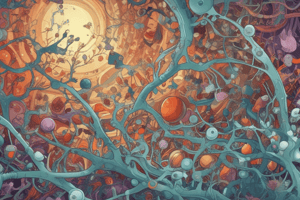Podcast
Questions and Answers
What are the classes of receptors based upon their common structure and function?
What are the classes of receptors based upon their common structure and function?
Receptors can be categorised into 4 classes:-
- Ligand gated ion channel (ionotropic receptors)
- G protein coupled receptors (metabotropic)
- Kinase linked receptors
- Nuclear receptors
How does the ligand gated ion channel receptor work?
How does the ligand gated ion channel receptor work?
The agonist (could be a neurotransmitter, drug, hormone) binds to the ligand gated ion channel receptor which opens the pore of the channel by moving the protein subunits to widen the gap. This allows the ions to go in or out of the cell. The response occurs in milliseconds.
What is the mechanism of nicotinic acetylcholine receptors?
What is the mechanism of nicotinic acetylcholine receptors?
Nicotinic acetylcholine receptors are membrane bound ligand gated ion channels. The acetylcholine neurotransmitter is bound in vesicles which activate the nicotinic acetylcholine receptors on the post synaptic receptors which allow the Na+ to go in and cause depolarisation and generate action potential (excitation).
What are the drugs that act as agonists at nicotinic acetylcholine receptors? What are their uses?
What are the drugs that act as agonists at nicotinic acetylcholine receptors? What are their uses?
What is the structure of the G protein coupled receptor?
What is the structure of the G protein coupled receptor?
What is the mechanism of a G protein coupled receptor?
What is the mechanism of a G protein coupled receptor?
What is the mechanism of adrenaline binding to adrenoreceptors?
What is the mechanism of adrenaline binding to adrenoreceptors?
What is the mechanism of action of alpha 1 adrenoreceptors? What is the outcome of activation?
What is the mechanism of action of alpha 1 adrenoreceptors? What is the outcome of activation?
What is the mechanism of action of alpha 2 adrenoreceptors?
What is the mechanism of action of alpha 2 adrenoreceptors?
What is the outcome of the activation of the alpha 2 adrenoreceptors?
What is the outcome of the activation of the alpha 2 adrenoreceptors?
Why is vasoconstriction from the activation of alpha 1 adrenoreceptors important?
Why is vasoconstriction from the activation of alpha 1 adrenoreceptors important?
Why is the activation of alpha 2 adrenoreceptors important?
Why is the activation of alpha 2 adrenoreceptors important?
What is the physiological effect of activation of beta 1 adrenoreceptors?
What is the physiological effect of activation of beta 1 adrenoreceptors?
What is the physiological effect of activation of beta 2 adrenoreceptors?
What is the physiological effect of activation of beta 2 adrenoreceptors?
What is the physiological effect of activation of beta 3 adrenoreceptors?
What is the physiological effect of activation of beta 3 adrenoreceptors?
Why can salbutamol not be prescribed in patients with a chronic case of asthma?
Why can salbutamol not be prescribed in patients with a chronic case of asthma?
What is the mechanism of action of treatment of chronic asthma?
What is the mechanism of action of treatment of chronic asthma?
What is an example of a phosphodiesterase inhibitor?
What is an example of a phosphodiesterase inhibitor?
How long is the time sale of response of G protein coupled receptors?
How long is the time sale of response of G protein coupled receptors?
What is the structure of kinase linked receptors?
What is the structure of kinase linked receptors?
What is the mechanism of action of kinase linked receptors?
What is the mechanism of action of kinase linked receptors?
What is the mechanism of action of insulin receptors?
What is the mechanism of action of insulin receptors?
What are the parallel signalling cascades in an insulin response?
What are the parallel signalling cascades in an insulin response?
What is the timescale of action of kinase linked receptors?
What is the timescale of action of kinase linked receptors?
What is the structure of nuclear receptors?
What is the structure of nuclear receptors?
What is the mechanism of action of nuclear receptors?
What is the mechanism of action of nuclear receptors?
What are the categories of drug targets?
What are the categories of drug targets?
Flashcards are hidden until you start studying




